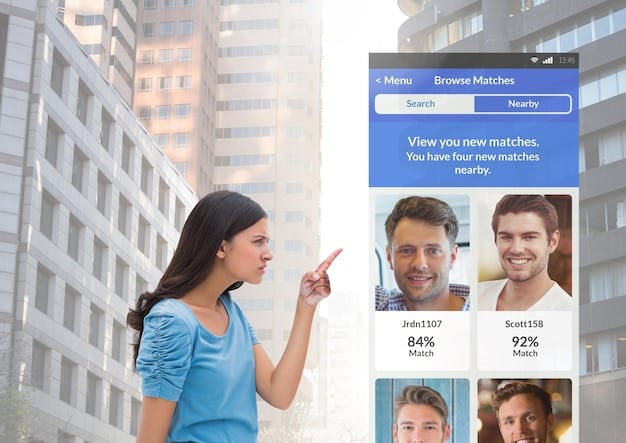Mobile-First Customer Service: Is Your Business Ready?
Customer service channels must adapt to the mobile-first generation by offering seamless, instant, and personalized experiences via smartphones and other mobile devices.
The rise of the mobile-first generation has fundamentally changed how customers interact with businesses. Are your customer service channels ready for the mobile-first generation? Adapting your customer service strategy to meet the demands of these digitally savvy customers is no longer optional; it’s essential for survival.
Understanding the Mobile-First Mindset
The mobile-first generation, comprised of millennials and Gen Z, has grown up with smartphones as an extension of themselves. Their expectations for customer service are drastically different from previous generations. Understanding these nuances is crucial for crafting a successful mobile customer service strategy.
Instant Gratification and Immediate Responses
Mobile-first customers expect immediate responses and instant gratification. They are accustomed to finding information and solutions quickly through search engines and social media. This expectation extends to customer service interactions.
Seamless, Personalized Experiences
These customers value seamless, personalized experiences across all channels. They expect your business to know who they are, what they’ve purchased, and what their previous interactions have been, regardless of the channel they’re using.
Here are some key characteristics of the mobile-first generation:
- They are digitally native and comfortable using a variety of mobile apps and platforms.
- They expect instant and personalized customer service.
- They prefer self-service options and proactive communication.
- They are quick to share their experiences (both positive and negative) on social media.
To truly meet the needs of the mobile-first generation, you must shift your perspective and prioritize mobile-friendly channels and strategies. This understanding lays the foundation for a robust plan that delivers value and enhances your customer’s overall journey.
Optimizing Your Mobile Customer Service Channels
Optimizing your existing customer service channels for mobile use involves significant adjustments to ensure a smooth and efficient experience. This includes adapting your website and communication methods to be mobile-friendly.

Mobile-Friendly Website and App Design
Your website and app must be designed for mobile devices. This means using responsive design principles so that they adapt to different screen sizes and resolutions. A mobile-friendly design ensures easy navigation, fast loading times, and a user-friendly interface.
Streamlining Communication
Streamlining communication requires optimizing email templates for mobile viewing, ensuring that information is concise and easy to find on smaller screens. Moreover, SMS/text messaging can be used for quick updates, confirmations, and support inquiries.
Optimizing your customer service channels for mobile involves the following steps:
- Ensure your website is responsive and mobile-friendly.
- Optimize email templates for mobile viewing.
- Offer SMS/text messaging for quick support inquiries.
- Incorporate mobile-first design principles in your app.
By focusing on optimization, you can create customer service experiences that are efficient, easy to use, and tailored for the mobile environment, meeting the demands of your mobile-first customers.
Leveraging Chatbots and AI for Mobile Support
Chatbots and AI are revolutionizing customer service, providing immediate and personalized support on mobile devices. These technologies streamline communication, reduce wait times, and improve overall customer satisfaction.
24/7 Availability and Instant Responses
Chatbots offer 24/7 availability, ensuring that customers can get assistance at any time, regardless of their location. They provide instant responses to common questions, reducing wait times and improving customer satisfaction.
Personalized Recommendations and Support
AI-powered chatbots can analyze customer data to provide personalized recommendations and support. They can understand customer inquiries, offer relevant solutions, and even escalate complex issues to human agents.
Leveraging chatbots and AI for mobile support involves:
- Implementing chatbots on your website and mobile app for 24/7 availability.
- Training chatbots to answer common customer service questions.
- Integrating AI to provide personalized recommendations and support.
By integrating these technologies, businesses create efficient, personalized, and continuously available customer service experiences, meeting the expectations of the mobile-first generation.
Integrating Social Media and Messaging Apps
Social media and messaging apps are integral to the lives of the mobile-first generation. Integrating these platforms into your customer service strategy is essential for reaching and engaging with your customers where they spend their time.

Providing Support on Popular Platforms
Offering customer service on platforms like Facebook, Twitter, and Instagram allows you to meet customers where they are. Monitoring these channels for mentions of your brand and responding to inquiries promptly can enhance customer satisfaction.
Using Messaging Apps for Direct Communication
Messaging apps such as WhatsApp and Messenger provide a direct and personal channel for customer communication. These apps allow for real-time conversations, multimedia support, and personalized assistance.
Integrating social media and messaging apps into your strategy will:
- Monitor social media channels for brand mentions and customer inquiries.
- Offer customer service on platforms like Facebook, Twitter, and Instagram.
- Utilize messaging apps such as WhatsApp and Messenger for direct support.
By leveraging these platforms, businesses can create highly responsive and personalized customer service channels, reinforcing positive brand perceptions among mobile-first customers.
Prioritizing Self-Service Options
Self-service options are highly valued by the mobile-first generation, who prefer to find answers on their own before contacting customer service. Providing robust self-service resources empowers customers and reduces the burden on your support team.
Knowledge Bases and FAQs
Creating comprehensive knowledge bases and FAQs allows customers to find answers to common questions quickly and easily. These resources should be mobile-friendly and easy to navigate.
Video Tutorials and How-To Guides
Video tutorials and how-to guides are highly engaging and effective self-service tools. They provide visual instructions and demonstrations that can help customers resolve issues on their own.
Prioritizing self-service options involves:
- Creating comprehensive knowledge bases and FAQs.
- Developing video tutorials and how-to guides.
- Ensuring self-service resources are mobile-friendly.
By prioritizing self-service, businesses can empower customers, reduce support inquiries, and create a more efficient and satisfying customer service experience, which resonates well with the mobile-first generation.
Measuring and Improving Mobile Customer Service
Measuring and improving your mobile customer service is critical for continuous optimization and alignment with customer expectations. Analyzing key metrics and gathering customer feedback allows you to identify areas of improvement and refine your strategy.
Tracking Key Metrics
Key metrics to track include customer satisfaction (CSAT) scores, Net Promoter Score (NPS), resolution times, and customer effort scores (CES). These metrics provide insight into the effectiveness of your mobile customer service channels.
Gathering Customer Feedback
Regularly collecting customer feedback through surveys, feedback forms, and social media listening helps you understand customer perceptions and identify pain points. Use this feedback to make informed decisions and improve your service.
Improving mobile customer service involves these actions:
- Track key metrics such as CSAT, NPS, resolution times, and CES.
- Gather customer feedback through surveys and social media listening.
- Analyze data to identify areas for improvement.
Consistent measurement and feedback loops are essential for ensuring the continuous improvement and relevance of your mobile customer service channels, ensuring they meet the evolving needs of mobile-first customers.
| Key Aspect | Brief Description |
|---|---|
| 📱 Mobile Optimization | Ensure your website and apps are fully responsive on mobile devices. |
| 🤖 AI Chatbots | Implement AI chatbots for instant, 24/7 support and personalized recommendations. |
| 💬 Social Media & Messaging | Integrate customer service into social media and messaging platforms like WhatsApp and Messenger. |
| 📚 Self-Service Resources | Provide comprehensive knowledge bases and video tutorials for self-service support. |
Frequently Asked Questions
▼
Mobile customer service is vital due to the increase in smartphone users. Modern customers expect immediate support directly from their mobile devices, influencing their brand perceptions and loyalty.
▼
Chatbots offer 24/7 instant assistance, automate responses to common queries, and provide personalized recommendations. This reduces wait times and enhances customer support efficiency, improving satisfaction.
▼
Key metrics include Customer Satisfaction (CSAT) scores, Net Promoter Score (NPS), resolution times, and Customer Effort Score (CES). Metrics highlight channel and support effectiveness.
▼
Social media and messaging apps provide direct lines of communication for immediate support. This enables personalized assistance and real-time conversations, catering to modern customer preferences.
▼
Self-service resources, like FAQs and video tutorials, empower customers to find answers independently. This availability reduces support loads, ensuring high usability for those technologically inclined.
Conclusion
Adapting your customer service channels for the mobile-first generation is a necessity in today’s digital landscape. By understanding their unique expectations, optimizing your mobile channels, leveraging new technologies, and prioritizing self-service options, you can create a customer service experience that meets their needs and exceeds their expectations.
